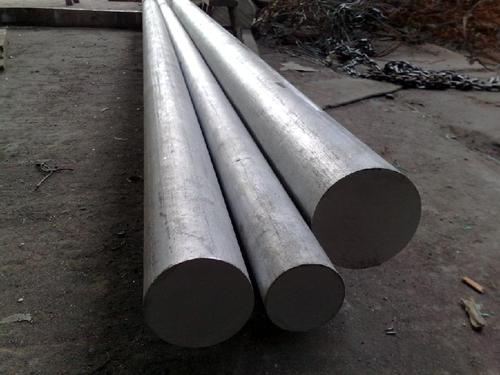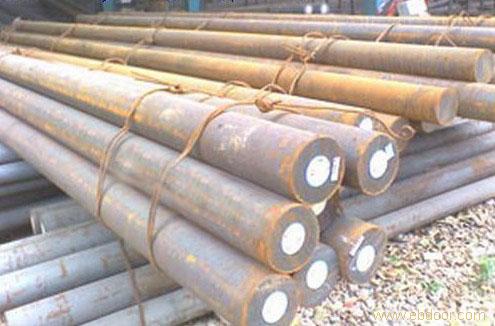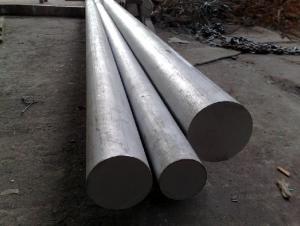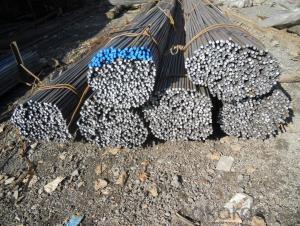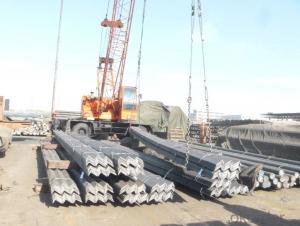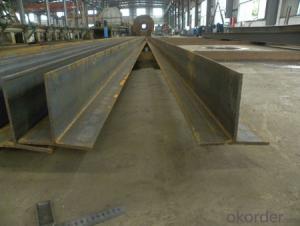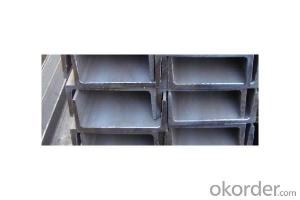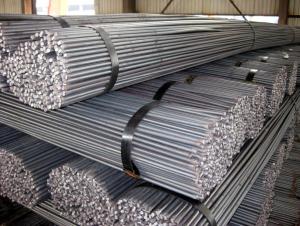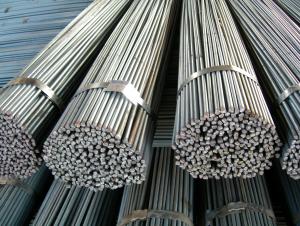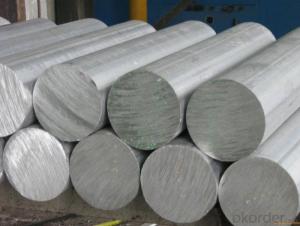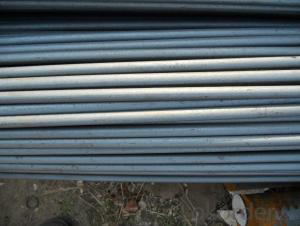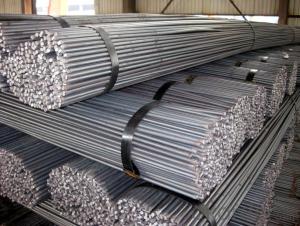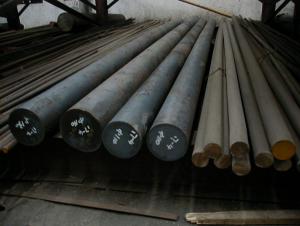Hot rolled round steel
- Loading Port:
- China Main Port
- Payment Terms:
- TT OR LC
- Min Order Qty:
- -
- Supply Capability:
- -
OKorder Service Pledge
OKorder Financial Service
You Might Also Like
TianGangQ345B round steel profile
Q345A (GB/T 1591-1994)/omega % properties and applications: q345 steel is a kind of material. It is a low alloy steel (c < 0.2%), comprehensive performance is good, good low temperature performance, cold stamping performance, good welding performance and cutting performance ° is widely used in pressure vessels, vehicles, ships, buildings, Bridges, etc. Q represents this kind of material yield, behind the 345, is refers to the material yield value, at around 345. And with the increase of the thickness of the material and reduce the yield value. Analogous to the naming of q235 method. Q345a, q345b, q345c q345d, q345e. And this is the distinction between grade, represents the main impact of temperature is different! Q345a, don't do impact; Grade q345b, impact is 20 degrees at room temperature; Grade q345c, impact is 0 degrees; Q345d grade, is 20 degrees - impact; Q345e level, it is - hit 40 degrees. In the impact of different temperature, impact value is also different.
Round steel series
Combination of steel, carbon steel, die steel, bearing steel, tool steel, spring steel, gear steel, cold-drawn round steel, hot rolled round steel, forging round steel.
Round steel material; 15 #, 8 #, 10 #, 20 #, 25 #, 30 #, 35 #, 45 #, 20 cr, cr, 35 to 40 cr, cr, 45 50 cr, mn, 15, 16 mn (q345b), q345c, q345d, q345e, 50 mn, 65 mn, < p > q235b 15 crmo (a3), 20 crmo, 35 crmo, 42 crmo, 5 crmnmo, 38 crmoal, yf45mnv, cr12 < p > cr12mov, gr15, mn2 40, 45 mn2, 60 si2mn crmnti 20, 20 mntib, ml35, t8a, t9a, t10a, t11a < p > t12a, t13a, 3 cr2w8v, 20 crmnmo, 40 crmnmo, 20 crnimo, 27 simn... ..
- Q: What is the difference between a polished and a hot rolled steel round bar?
- The manufacturing processes and resulting surface finishes distinguish polished steel round bars from hot rolled ones. To produce hot rolled steel round bars, a steel billet or ingot is heated to high temperatures and then shaped into a round bar through rolling. This method yields a surface finish that is rough and uneven, with mill scale and imperfections. Hot rolled bars are typically utilized in applications where surface finish is not crucial, such as structural components, machinery parts, and construction materials. In contrast, polished steel round bars undergo additional steps to achieve a smooth and glossy surface finish. Following the hot rolling process, these bars undergo various grinding and polishing techniques to eliminate mill scale, surface imperfections, and achieve a consistent finish. The result is a refined and visually appealing surface, suitable for applications where appearance matters, such as decorative items, furniture, and architectural components. Aside from surface finish, the mechanical properties of the two types of steel round bars can also differ. Hot rolled bars tend to possess a rougher surface and may exhibit residual stresses, while polished bars feature a smoother surface and reduced internal stresses. However, the overall mechanical properties, including strength and hardness, are predominantly determined by the grade and composition of the steel used, rather than the manufacturing process or surface finish. In conclusion, the discrepancy between polished and hot rolled steel round bars lies in their surface finish. Hot rolled bars have a rough and uneven surface with mill scale and imperfections, while polished bars undergo further processing for a smooth and glossy finish. The choice between the two depends on the specific application and desired appearance of the final product.
- Q: Are steel round bars suitable for use in the automotive industry?
- Yes, steel round bars are commonly used in the automotive industry due to their strength, durability, and versatility. They are used in various applications such as axle shafts, drive shafts, suspension components, and engine parts. The high tensile strength and resistance to wear make steel round bars ideal for handling heavy loads and enduring demanding conditions in vehicles.
- Q: What is the difference between a seamless and a precision ground steel round bar?
- A solid cylindrical steel billet is heated and pierced to create a hollow tube-like structure, resulting in a seamless steel round bar. This manufacturing method guarantees a uniform outer diameter throughout the entire length of the bar, making it ideal for applications that necessitate a smooth surface finish and high dimensional accuracy. Industries such as oil and gas, automotive, and aerospace commonly employ seamless round bars. On the contrary, a precision ground steel round bar is produced by subjecting a hot-rolled or cold-drawn steel bar to precise grinding processes. These processes eliminate any surface imperfections, achieve meticulous dimensional tolerances, and provide a polished and smooth finish. Precision ground round bars are typically utilized in applications that require strict tolerances, superior surface finish, and consistent dimensions, such as in the production of machinery parts, tools, and components. In conclusion, the primary distinction between a seamless and a precision ground steel round bar lies in the manufacturing process and the resulting characteristics. Seamless round bars are formed from a hollow tube-like structure, ensuring a consistent outer diameter, whereas precision ground round bars are created by grinding a solid steel bar to achieve tight tolerances and exceptional surface finish. Both types of round bars offer their own advantages and find application in various industries based on specific requirements.
- Q: What are the advantages of using shock-resistant steel round bars?
- There are several advantages of using shock-resistant steel round bars in various applications. Firstly, shock-resistant steel round bars are designed to withstand high impact and shock loads, making them ideal for use in industries such as construction, automotive, and manufacturing. This property of shock resistance ensures that the round bars remain intact and maintain their structural integrity even under extreme conditions. Another advantage of shock-resistant steel round bars is their enhanced durability. These round bars are made from high-quality steel alloys that have been specifically engineered to provide superior strength and resistance to wear and tear. This makes them highly resistant to bending, cracking, and fracture, ensuring a longer lifespan compared to regular steel round bars. Additionally, shock-resistant steel round bars offer improved safety in applications where there is a risk of impact or sudden loads. By using these round bars, the likelihood of structural failure or catastrophic accidents is significantly reduced, providing a greater level of security for both workers and the overall operation. Moreover, shock-resistant steel round bars are known for their excellent machinability and weldability. This means that they can be easily shaped, cut, and welded to meet specific requirements, allowing for versatility in design and manufacturing processes. This ease of manipulation makes them a preferred choice for various projects where customization is necessary. Furthermore, shock-resistant steel round bars offer cost-effective solutions. Due to their high durability and resistance to wear, they require less frequent replacements, resulting in reduced maintenance and replacement costs. Additionally, their ability to withstand shock loads reduces the need for additional reinforcement or support structures, further reducing overall project expenses. In conclusion, the advantages of using shock-resistant steel round bars include high impact resistance, enhanced durability, improved safety, excellent machinability, and cost-effectiveness. These properties make them a reliable and efficient choice for a wide range of applications, ensuring long-lasting and reliable performance.
- Q: How are steel round bars inspected for quality?
- Steel round bars are inspected for quality through various methods to ensure that they meet the required standards. The inspection process typically involves both visual examination and testing procedures. Visual inspection is the first step in assessing the quality of steel round bars. Qualified inspectors visually examine the bars for surface defects such as cracks, scratches, dents, or any other irregularities that may affect the structural integrity or performance of the bars. Additionally, dimensional inspection is conducted to verify the diameter, length, straightness, and overall shape of the round bars. This is done using precision measuring instruments to ensure that the bars meet the specified tolerances and requirements. Aside from visual inspection, various testing methods are employed to evaluate the mechanical properties and chemical composition of the steel round bars. The most common testing procedures include: 1. Tensile Testing: This test measures the strength and ductility of the steel bars by subjecting them to tension until they fracture. It helps determine the ultimate tensile strength, yield strength, and elongation of the material. 2. Hardness Testing: It is performed to assess the hardness of the steel round bars, which is an indicator of its resistance to deformation or wear. The most commonly used methods for hardness testing are Rockwell, Brinell, and Vickers hardness tests. 3. Ultrasonic Testing: This non-destructive testing method uses high-frequency sound waves to detect any internal defects or discontinuities in the steel bars. It helps identify flaws such as cracks, inclusions, or voids that may negatively impact the material's quality. 4. Chemical Analysis: Steel round bars undergo chemical analysis to determine the chemical composition and ensure it meets the required specifications. This analysis helps verify the percentages of different alloying elements present in the steel, ensuring it has the desired properties. All these inspection methods are conducted by trained professionals or certified third-party inspectors who are knowledgeable about the specific industry standards and guidelines. By combining visual examination and precise testing techniques, the quality of steel round bars can be thoroughly assessed, ensuring they are fit for their intended applications.
- Q: Are steel round bars suitable for use in the manufacturing of fittings?
- Yes, steel round bars are suitable for use in the manufacturing of fittings. Steel round bars offer several advantages that make them a preferred choice for fittings manufacturing. Firstly, steel is known for its excellent strength and durability, making it ideal for creating reliable and long-lasting fittings. Steel round bars are capable of withstanding heavy loads and high pressure, ensuring that the fittings can perform effectively in various applications. Additionally, steel round bars are highly versatile and can be easily shaped and formed into different fittings designs. This flexibility allows manufacturers to create fittings that meet specific requirements and dimensions, ensuring a perfect fit for various systems and structures. Moreover, steel is resistant to corrosion, which is essential for fittings that may come into contact with moisture or other corrosive substances. The anti-corrosion properties of steel ensure that fittings maintain their integrity and functionality over time, even in harsh environments. Furthermore, steel round bars are readily available in a wide range of sizes, grades, and finishes, providing manufacturers with ample options to meet different specifications and design preferences. In conclusion, steel round bars are a suitable choice for use in the manufacturing of fittings due to their strength, durability, versatility, corrosion resistance, and availability. These attributes make steel round bars a reliable and efficient material for creating high-quality fittings that can withstand various operating conditions and provide long-lasting performance.
- Q: Can steel round bars be used in marine environments?
- Yes, steel round bars can be used in marine environments, but they need to be made from corrosion-resistant materials such as stainless steel or galvanized steel to withstand the corrosive effects of saltwater.
- Q: Can steel round bars be used in the production of sporting goods?
- Yes, steel round bars can be used in the production of sporting goods. Steel is a durable and strong material that can provide stability and support for various sporting equipment such as weights, bars for weightlifting, poles for pole vaulting, or components for bicycles and golf clubs.
- Q: What are the advantages of using precipitation-hardening steel round bars?
- There are several advantages of using precipitation-hardening steel round bars. Firstly, these bars offer high strength and toughness, making them suitable for applications that require heavy load-bearing capacity. Secondly, they have excellent corrosion resistance, making them ideal for use in harsh environments or exposed to corrosive elements. Additionally, precipitation-hardening steel round bars can be easily machined and formed into various shapes, providing versatility in design and manufacturing. Lastly, these bars possess good dimensional stability, ensuring consistent performance and reliable results in critical applications.
- Q: What are the different types of steel round bar surface treatments used in the automotive industry?
- In the automotive industry, the most common types of steel round bar surface treatments used are galvanization, electroplating, and powder coating. Galvanization involves coating the steel with a layer of zinc to protect it from corrosion. Electroplating is a process where a thin layer of another metal, such as chrome or nickel, is applied to the steel surface for enhanced aesthetics and protection. Powder coating, on the other hand, involves applying a dry powder to the steel surface and then curing it under high heat to create a durable and attractive finish. These surface treatments help improve the durability, appearance, and overall performance of steel round bars used in automotive applications.
Send your message to us
Hot rolled round steel
- Loading Port:
- China Main Port
- Payment Terms:
- TT OR LC
- Min Order Qty:
- -
- Supply Capability:
- -
OKorder Service Pledge
OKorder Financial Service
Similar products
Hot products
Hot Searches
Related keywords



